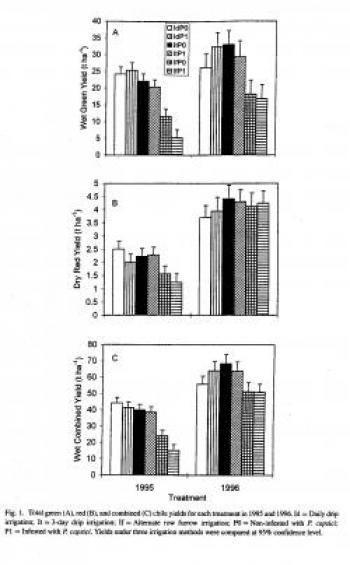Chile
Irrigation Method Effects
Effects of irrigation method on chile pepper yield and Phytophthora root rot incidence. 1999 Jinhue. Xie, E. S. Cardenas, T. W. Sammis, M. M. Wall, D. Lindsey, and L. .W. Murray. Ag. Water Management 42:127-142
ABSTRACT
A field experiment was conducted in 1995 and 1996 to examine the effects of different irrigation methods on yields and Phytophthora root rot disease of chile plants (Capsicum annum New Mexico Ë-6-4"). Three irrigation methods, daily drip, 3-day drip, and alternate row furrow irrigation, were applied to plots infested with P. capsici and uninfested plots. For both years, the drip irrigation (either daily or 3-day) created higher marketable green chile yields than the alternate row furrow irrigation (p <0.05), and the yields between the daily and 3-day drip irrigation were statistically similar. The effect of irrigation on marketable combined yields was similar to that on green chile yields. In 1995, root rot disease incidence in the infested plots was significantly higher under alternate row furrow irrigation than for daily and 3-day drip irrigation. There was no disease development in the uninfested plots regardless of the irrigation method. The disease decreased green chile yield by 55% (p <0.1), and combined yield (green + red chile) by 36% (p <0.1) in 1995 compared to that in uninfested plots in alternate row furrow irrigation. In 1996, however, no disease occurred in any treatment. The results suggested that drip irrigation increases chile yield through providing either favorable soil moisture conditions or unfavorable conditions for Phytophthora propagation.


To convert from green weight to dry weight divide by 8.